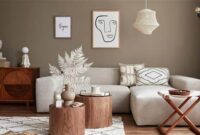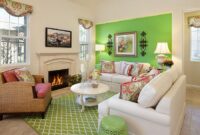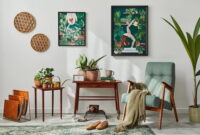Living Room Design – Creating a comfortable, stylish, and functional living room is at the heart of any home design. Your living room isn’t just a space for entertaining guests—it’s where you relax, unwind, and express your personal style. This guide provides a wealth of living room design inspiration with modern trends, practical ideas, and tips to help you design a space that truly feels like home.
Table of Contents
ToggleUnderstanding Your Living Room Style
Choosing a specific style for your living room sets the tone for your entire home decor. With so many styles available, from minimalist to bohemian and Scandinavian, it’s important to decide what resonates with you. Here are a few popular styles to consider:
Minimalist Living Room Design
For those who appreciate simplicity and clean lines, a minimalist style is ideal. This design is characterized by neutral color schemes, decluttered spaces, and functional furniture.
Key Features:
- Neutral tones like white, beige, and gray
- Simple, streamlined furniture
- Minimal decorations and accessories
Minimalism emphasizes functionality, making it easier to maintain a clean and organized living room. To achieve this look, choose a comfortable sofa in a neutral shade, a simple coffee table, and perhaps a few plants for a touch of nature.
Bohemian Living Room Design
The bohemian style brings an eclectic mix of textures, colors, and patterns into your space. This style allows for self-expression through bold accessories, colorful rugs, and unique wall art.
Key Features:
- Vibrant colors and patterns
- Mix of textures, from rugs to pillows
- Vintage furniture and accessories
In a bohemian room, don’t be afraid to layer textures, from woven rugs to embroidered cushions.
Modern Scandinavian Style
Scandinavian design is a combination of functionality and simplicity, focusing on light colors, natural elements, and a mix of textures.
Key Features:
- Light wood and white tones
- Minimalist furniture with a modern touch
- Use of natural light and plants
A Scandinavian living room often includes a light-colored sofa, a wooden coffee table, and simple, elegant decor pieces.
Essential Living Room Furniture Choices
Choosing the right furniture is essential to a well-designed living room. Your furniture should be comfortable, functional, and suit the style you’ve chosen.
Sofas and Seating Options
The sofa is usually the main focal point in any living room. Depending on the room size and layout, you can opt for a sectional sofa, loveseat, or a traditional three-seater.
Popular Options:
- Sectional Sofas: Great for large living rooms or open-concept spaces.
- Loveseats: Perfect for smaller rooms or to add additional seating.
- Recliners and Armchairs: Provide comfort and style, perfect for reading nooks.
When choosing a sofa, consider the upholstery material. Leather sofas offer durability and a sleek look, while fabric sofas provide comfort and a variety of color options.
Tables and Storage Solutions
Every living room needs a table and some storage. A coffee table anchors the seating area, while side tables and consoles offer additional surfaces for decor and lighting.
- Coffee Tables: Wooden, glass, and metal options are popular, each bringing a different vibe to the room.
- Side Tables: These can double as storage, ideal for remote controls, books, or magazines.
- TV Consoles: A modern TV console not only houses your media equipment but can also serve as a design feature.
Multipurpose Furniture
For smaller spaces, multipurpose furniture like storage ottomans and foldable tables can help maximize functionality without sacrificing style.
Living Room Color Schemes and Lighting
Color and lighting play a significant role in creating the desired atmosphere in your living room. While lighter tones make a room feel airy and spacious, darker tones add depth and warmth.
Choosing the Right Color Palette
When picking colors, think about how they reflect your style and mood.
- Neutral Colors: Beige, gray, and white create a serene and timeless feel.
- Bold Colors: Use vibrant colors like teal, mustard yellow, or forest green as accents in a neutral room.
- Earth Tones: Warm shades like terracotta, taupe, and olive green add a natural and cozy touch.
Layering Lighting for Ambiance
Effective lighting combines different sources to create layers, including ambient, task, and accent lighting. Each type serves a purpose and enhances the room’s overall aesthetic.
- Ambient Lighting: Overhead lights or chandeliers for general lighting.
- Task Lighting: Floor lamps or table lamps for reading or working.
- Accent Lighting: Wall sconces, LED strips, or spotlights for highlighting artwork or architectural features.
Using a combination of these lights can make your living room design feel balanced and adaptable.
Adding Decorative Elements
After the furniture and color scheme are in place, decor items help bring life and personality into the room. Here are some ideas to consider:
Wall Art and Mirrors
Wall art can be the centerpiece of a living room, adding visual interest and character.
- Gallery Wall: Create a collection of framed prints, photos, or paintings for a unique display.
- Large Mirrors: Place mirrors strategically to make the room feel larger and brighter.
Mirrors can also reflect light, enhancing your room’s natural lighting and creating an illusion of more space.
Rugs and Textiles
Adding textiles like rugs, curtains, and cushions adds texture and warmth to the room.
- Area Rugs: These define the seating area and add color or pattern. A neutral rug complements minimalist spaces, while a patterned rug suits eclectic styles.
- Curtains: Choose curtains that complement your color scheme and style. Light, sheer curtains are great for a bright, airy look, while heavy drapes add drama.
Rugs and textiles help ground the space and make it feel cozy and inviting.
Greenery and Plants
Plants bring a touch of nature indoors and improve the air quality. Choose low-maintenance plants like snake plants, succulents, or pothos that thrive indoors.
Tip: Place a few plants in varying heights around the room for a natural, balanced look.
Budget-Friendly Living Room Design Tips
Designing a stylish living room doesn’t have to be expensive. Here are a few tips to help you create a beautiful space without breaking the bank:
DIY Decor and Furniture Hacks
There are many ways to repurpose old furniture and create custom decor pieces that add personality and save money.
- Repaint Old Furniture: Give tables and chairs a fresh coat of paint to match your style.
- DIY Art: Create simple wall art with affordable materials like canvas and paint.
- Upcycle Items: Turn items like crates into shelves or side tables.
Shopping Smart
When shopping, look for sales or discounts on large furniture items. Many furniture stores have annual sales, making it possible to find quality pieces at affordable prices.
Opt for Affordable Accents
Invest in a few statement pieces, like a unique rug or a bold lamp, and then complement them with budget-friendly decor. Look for decor items like cushions, throw blankets, and small decor pieces that don’t cost much but still add style.
Conclusion
Whether you’re designing a new living room or updating your current space, there are endless ways to personalize it to match your style, budget, and needs. By choosing a cohesive design style, the right furniture, and adding layers of lighting and decor, you can create a living room that’s both stylish and functional. From minimalism to bohemian vibes, and budget-friendly tips, these ideas offer living room design inspiration for any home,




